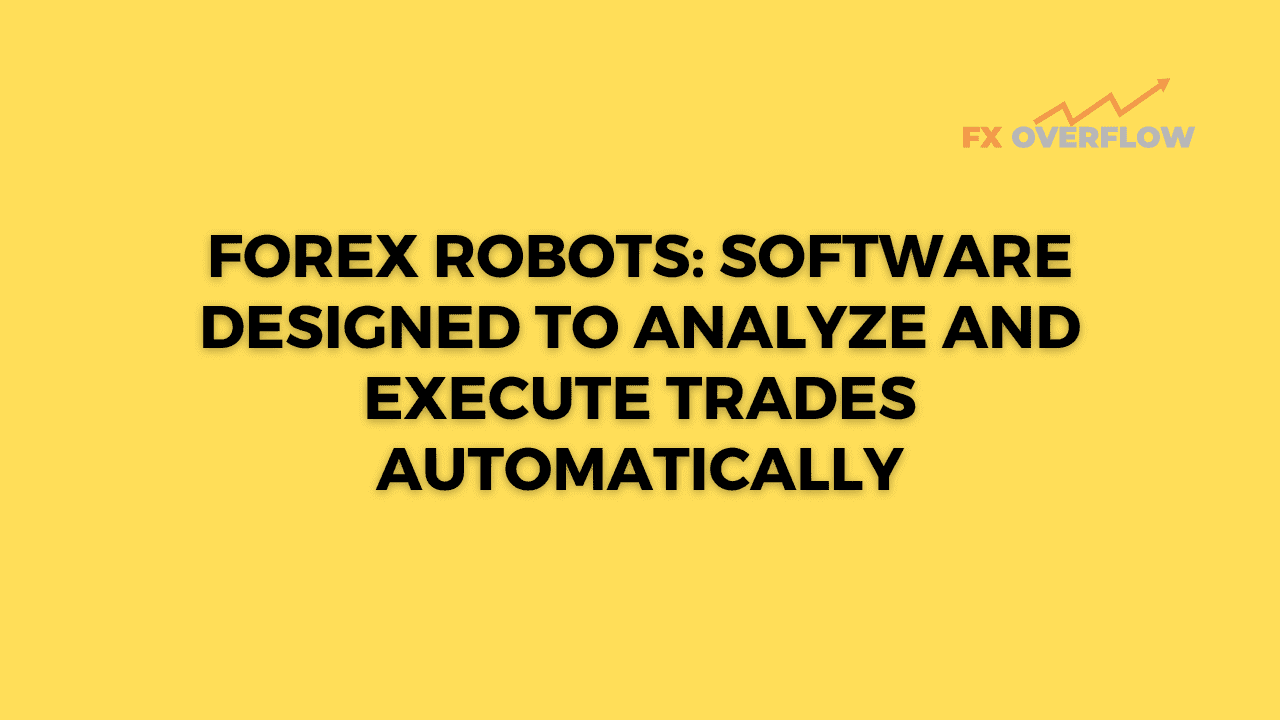Forex Robots: Software Designed to Analyze and Execute Trades Automatically
In the ever-evolving world of financial markets, trading has witnessed a dramatic transformation with the advent of Forex robots. These sophisticated software solutions are designed to analyze market data and execute trades automatically, freeing traders from manual interventions. This article explores the concept of Forex robots, delves into their functionalities, and analyzes their impact on the trading landscape.

Table Content
1. The Rise of Forex Robots
2. How Forex Robots Work
3. Pros and Cons of Forex Robots
4. Table: Pros and Cons of Forex Robots
5. Forex Robots vs. Manual Trading: A Comparative Analysis
6. Evaluating the Effectiveness of Forex Robots
7. The Future of Forex Robots
The Rise of Forex Robots
Forex robots, also known as Expert Advisors (EAs), are algorithmic trading systems that operate within the MetaTrader platform. Their popularity has surged due to the numerous advantages they offer, such as:
- Automation: Forex robots eliminate the need for continuous monitoring and manual execution of trades. They can operate 24/7, even in the absence of traders.
- Speed and Efficiency: These robots can process vast amounts of market data in real-time, enabling them to identify opportunities and execute trades swiftly.
- Emotion-Free Trading: Unlike human traders, Forex robots are not influenced by emotions like fear and greed, leading to more objective decision-making.
- Backtesting and Optimization: Traders can test the robot's performance on historical data and optimize its settings to enhance profitability.

How Forex Robots Work
Forex robots rely on a set of predefined rules and indicators to analyze market conditions and identify potential trading opportunities. Here's a simplified overview of their functioning:
- Data Gathering: The robot collects and processes a wide range of market data, including price movements, volume, and technical indicators.
- Strategy Formulation: Based on the gathered data, the robot applies its programmed strategy to identify entry and exit points for trades.
- Trade Execution: When the conditions match the strategy's criteria, the robot automatically executes the trades on the trader's behalf.
- Risk Management: Forex robots often incorporate risk management rules to protect the trader's capital, such as stop-loss and take-profit levels.
Pros and Cons of Forex Robots
Forex robots offer several benefits, but they also come with certain drawbacks. Understanding these aspects is crucial for traders considering their adoption.
Table: Pros and Cons of Forex Robots

Forex Robots vs. Manual Trading: A Comparative Analysis
The debate between using Forex robots and manual trading remains a topic of interest among traders. Let's compare the two approaches:
- Decision Making: Forex robots rely on predefined algorithms, while manual trading involves subjective decision-making based on market analysis.
- Speed and Efficiency: Robots can execute trades instantly, whereas manual traders may experience delays in executing orders.
- Emotional Factors: Manual traders are susceptible to emotional biases, while robots remain unaffected by such sentiments.
- Flexibility: Manual traders can adapt their strategies to changing market conditions, whereas robots may struggle with dynamic scenarios.
Evaluating the Effectiveness of Forex Robots
Evaluating the effectiveness of Forex robots involves considering several factors, including:
- Historical Performance: Analyzing past trading results through backtesting can provide insights into the robot's potential.
- Risk Management: Understanding how the robot handles risk through stop-loss and take-profit mechanisms.
- Market Conditions: Assessing how the robot performs in various market conditions, including trending and ranging markets.
- User Reviews and Feedback: Gathering opinions from other traders who have used the specific Forex robot can be invaluable.
The Future of Forex Robots
The continuous advancements in artificial intelligence and machine learning are likely to shape the future of Forex robots. Here are some potential developments:
- Enhanced AI Capabilities: Forex robots may integrate more sophisticated AI algorithms to adapt to changing market dynamics.
- Broader Asset Coverage: Robots could expand their capabilities to trade not only in the Forex market but also in other financial markets.
- Interconnectivity: Integration with other platforms and exchanges could lead to seamless cross-market trading.
Footnote
Forex robots have emerged as powerful tools that offer automation, speed, and precision in executing trades. Their ability to function without emotional biases and their potential for maximizing trading efficiency make them attractive to traders. However, it is essential to consider the limitations and perform thorough evaluations before integrating them into trading strategies.
Please support us by hitting the like button on this prompt. This will encourage us to further improve this prompt to give you the best results.
FAQs
- Are Forex robots suitable for beginners?
- While Forex robots automate trading, beginners should still grasp the basics of trading and risk management before using them.
- Can Forex robots guarantee profits?
- No, there are no guarantees in trading. Forex robots can assist, but profitability depends on various market factors.
- What are the risks of using Forex robots?
- Risks include technical failures, strategy limitations, and dependence on historical data.
- Do I need programming skills to use Forex robots?
- Some platforms offer user-friendly interfaces, eliminating the need for extensive programming knowledge.
- Can I use multiple Forex robots simultaneously?
- Yes, but careful evaluation and coordination between robots are necessary to avoid conflicts and redundancies.











Discussion